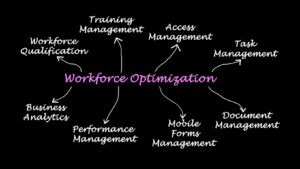
In the bustling world of business, efficiency is king. Companies are constantly seeking ways to streamline processes and boost productivity. Enter the workforce optimization system, a powerful tool that’s changing the game for businesses big and small.
This system isn’t just a fancy buzzword—it’s a strategic approach that leverages technology to maximize workforce potential. From scheduling and task management to performance monitoring, it’s reshaping how businesses operate.
Stay tuned as we delve into the intricacies of the workforce optimization system, exploring its many facets and the transformative impact it’s having on today’s business landscape.
Workforce Optimization System
A workforce optimization system, at its core, is a technologically advanced tool that integrates various aspects like scheduling, task management, and performance monitoring. It leverages analytics to streamline these processes and optimize workforce productivity. By synchronizing multifaceted components of a business – from real-time analytics to operational updates, it bridges gaps in communication, thus enhancing workflow efficiency. For instance, an advanced tool in the market, Genesys, blends automation and analytics, empowering its users to drive business performance and provide superior customer service.
Importance of Workforce Optimization System
 Workforce optimization systems are instrumental for maintaining a competitive edge in today’s dynamic business landscape. They enable companies to make informed decisions by analyzing real-time data, thereby improving resource allocation and maximizing efficiency. Commendably, these systems also facilitate proactive management, enabling swift adaptations to unexpected changes in the business environment. For example, Nice, a market leader in this domain, provides solutions connecting multiple business units, thereby streamlining operations, improving response times, and enhancing customer satisfaction.
Workforce optimization systems are instrumental for maintaining a competitive edge in today’s dynamic business landscape. They enable companies to make informed decisions by analyzing real-time data, thereby improving resource allocation and maximizing efficiency. Commendably, these systems also facilitate proactive management, enabling swift adaptations to unexpected changes in the business environment. For example, Nice, a market leader in this domain, provides solutions connecting multiple business units, thereby streamlining operations, improving response times, and enhancing customer satisfaction.
Features of a Robust Workforce Optimization System
Digging deeper into the facets of a competent workforce optimization system, these tools are imbued with several core features to improve business operations. Key attributes include streamlined planning, real-time monitoring capabilities, and comprehensive analytics which contribute immensely to operational efficiency.
Streamlined Planning and Scheduling
Centralizing planning and scheduling tasks is critical to a workforce optimization system. By leveraging automation, these systems eliminate common bottlenecks, such as scheduling conflicts, overlapping shifts, or under-staffing. They capture employee availability, skill sets, and preferred shifts, creating optimal schedules that consider both business needs and employee satisfaction. Examples include Injixo and Verint, which offer tools to balance workload and workforce, keeping operations running smoothly.
Real-time Monitoring
 Immediate oversight is another paramount feature of sophisticated workforce optimization systems. Offering real-time monitoring, these systems trace employee performance, spot inefficiencies, and indicate areas for improvement. They utilize advanced technologies to capture real-time data on a wide range of metrics, offering insights that help managers take swift, informed decisions. For instance, Aspect’s Workforce Optimization software provides real-time tracking and historical reporting to aid performance assessments.
Immediate oversight is another paramount feature of sophisticated workforce optimization systems. Offering real-time monitoring, these systems trace employee performance, spot inefficiencies, and indicate areas for improvement. They utilize advanced technologies to capture real-time data on a wide range of metrics, offering insights that help managers take swift, informed decisions. For instance, Aspect’s Workforce Optimization software provides real-time tracking and historical reporting to aid performance assessments.
Comprehensive Analytics
A robust workforce optimization system is incomplete without a comprehensive analytics suite. Detailed analytics pave the way for more informed decision-making by extracting significant insights from large volumes of data. This includes performance metrics, skill analytics, trend analysis, and more. By using these insights, businesses can better understand their workforce and make strategic changes to increase productivity. Tools like Calabrio ONE are prime examples, offering rich analytics to uncover hidden trends and patterns in workforce data.
Benefits of Implementing a Workforce Optimization System
 Embracing a workforce optimization system is a strategic move for businesses seeking to outperform their competition. It’s a game-changer, transforming the way they manage their operations. With tools like Injixo, Verint, Aspect, and Calabrio ONE, businesses can streamline planning, monitor performance in real time, and leverage comprehensive analytics.
Embracing a workforce optimization system is a strategic move for businesses seeking to outperform their competition. It’s a game-changer, transforming the way they manage their operations. With tools like Injixo, Verint, Aspect, and Calabrio ONE, businesses can streamline planning, monitor performance in real time, and leverage comprehensive analytics.
These systems don’t just boost productivity; they also empower businesses to make informed decisions. They provide a clear picture of the workforce’s performance, enabling proactive management. The benefits are clear: efficiency, improved decision-making, and ultimately, a significant competitive advantage.
Investing in a robust workforce optimization system is not just about enhancing operational efficiency. It’s about reshaping the business landscape, setting a new standard for productivity, and driving growth. It’s the future of business operations, and it’s here now.
